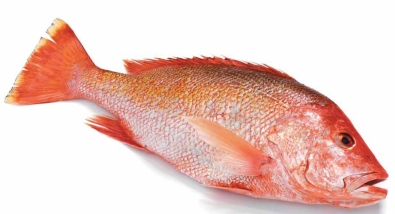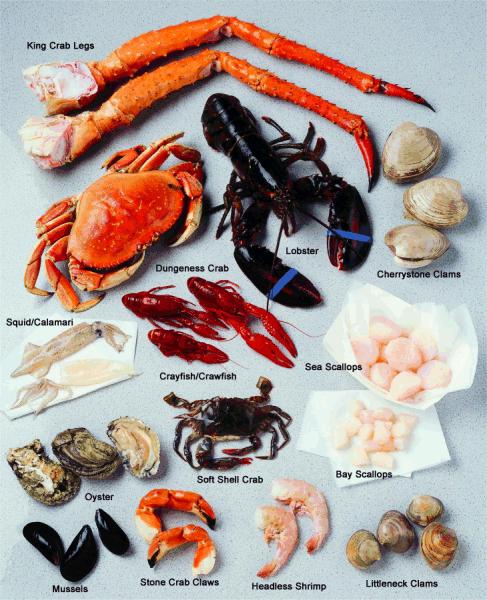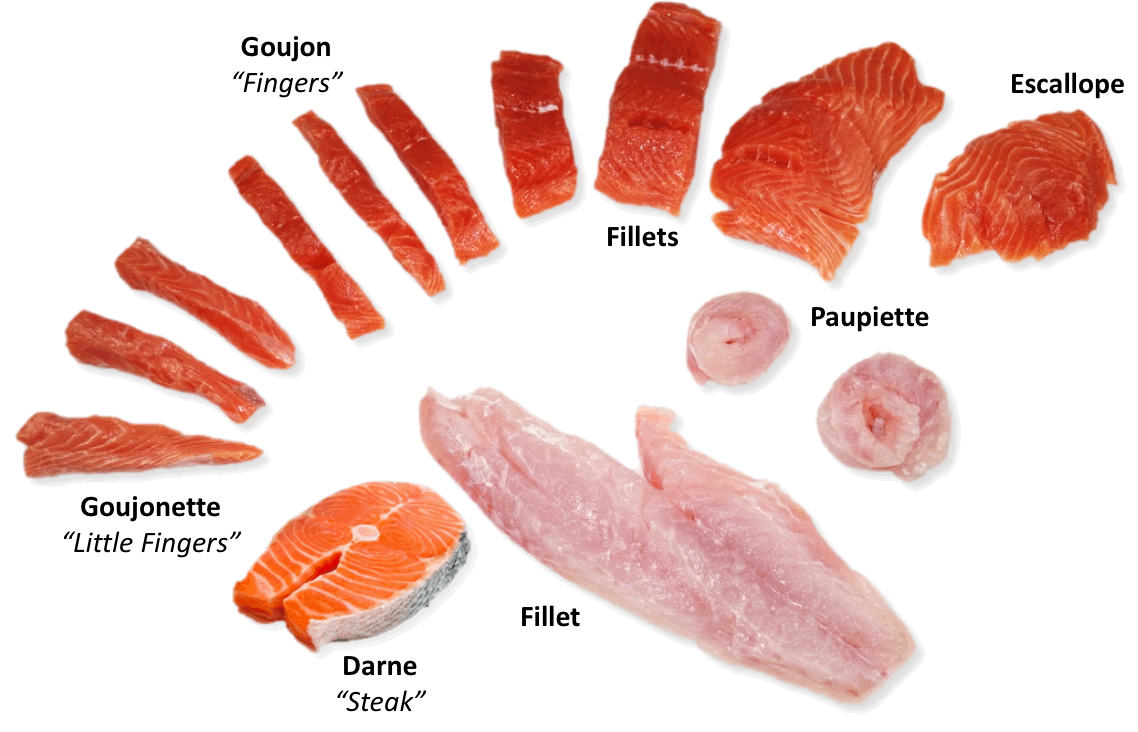Fish are aquatic vertebrates with fins for swimming and gills for breathing.
Fish is a high protein food, supplying on an average a little more than 5 gm of protein/ edible ounce (1oz= 25 gm)
SEAFOOD – A collective term for shellfish and other small edible marine animals like crabs, mussels, shrimps, winkles, sea urchin etc. Seafood may be served as a main course or as a special appetizer course featuring delicacies like smoked salmon, oysters, baked clams, fried calamari etc which are often served accompanied by butter and rye bread or served raw on a bed of ice.
FLAT FISH: It has four fillets.
ROUND FISH: It has two fillets
 .
.
CLASSIFICATION OF FISH:
FIN FISH –
white fish ( contains fats only on liver and there are mainly flat fish except cod)
oily fish ( contains fat all over the body and these are all round fish )
SHELL FISH

FIN FISH: are vertebrates and have skin and scales which cover their body. They move with the help of fins.They are subdivided into 1.lean / white fish (0.5 % – 4% of fat), the most numerous which includes all the cods family (haddock, whiting etc) and white flat fish ( plaice, sole etc) and the perch family ( bass, red mullet and skate etc). Most of these fishes are deep sea fishes. 2. Oily fish : the amount of fat varies from 4%- 20 %, these fishes are often pigmented and tend to be surface fish ( lives in the surface level of water). For example sardine, mackerel, herring, trout (fat content of these fishes lie between 4%- 10%), tuna ( 13% fat), salmon ( 12% fat), moray and lamprey ( 13%-17% fat)
SHELL FISH: as the name denotes have a shell covering the body. They are invertebrates and subdivided into:
1. Molluscs – which are again subdivided into univalves- they are recognized by the characteristics spiral formation on their shell, which are not divided into halves. Ex- winkles.
Bivalves-which have two distinctly separate shells, joined by a hinge like membrane. The movement of the shell is controlled by strong muscles when the muscles relaxes, the two shell of the shell fall open. The shell also open, when the organism dies, does exposing the content of the shell to contamination from outside, resulting in quick decomposition. For example clams, cockles, mussels, oysters, scallops etc.
The shells of mollusks increase at the arte of 1 ring per year to allow for the growth of the organism. The age of mollusk can does be estimated by the numbers of rings on the shell.
- Crustaceans: these arthropods( a group of invertebrates with a shell and paired legs) having a segmented, crust like shell and most of them are marine. The marine crustaceans includes lobster, langoustes, crabs, shrimp etc. the only fresh water crustaceans used in cookery is the crayfish.
The shell of the crustaceans do not go with the fish, unlike those of the molluscs, but are shed each year with a new one forming to suit their size.
- Cephalopods: The word literally means “head with foot”.
Buried in the flesh of all cephalopods is the duplicate skeleton which is usually transparent and found in the form of – a long pen in a squid, an oval cuttlebone or a hard beak of an octopus.
Cephalopods are marine animals which do not have any backbone also termed as invertebrates.
Quick cooking over high heat or long slow cooking is the rule for cephalopods.
Examples of cephalopods are – octopus, squid, cuttlefish and jellyfish.
Squids are considered to be more sweet and tender than cuttlefish.
QUALITIES FOR A GOOD FISH –
- Fish should look and smell fresh.
- The scales should be intact, firmly adhering and shiny.
- The eyes should be full and bulging but not sunken.
- The gills of the fish should be bright red.
- When poked or pressed with fingers the flesh should feel firm and resilient (resisting, when poked it comes back to its original shape.)
- Guts (organs specially related to digestive system) – belly should not be torn, sagging or swollen. When the fish is open, the guts should be smooth and clean.
- To taste a cut piece of fish, press down with a finger and if impression is left then the fish is stale. Raw flesh should not come away from the bones as it is the sign of fish detoriation.
HOW TO SELECT SHELL FISH :
They should be bought in season as far as possible. They should medium sized and of good weight. It is best to buy them alive, particularly oyster, crabs and lobsters.
- If they are died the following precautions should be taken-
- The claws of crabs should be springy and not hanging down.
- The eyes should be bright.
- The tail of lobsters should spring back when stretched out.
- Shrimp and prawns must be crisp
- Oyster shells should be tightly closed.
STORING FISH –
- Fresh fish should be stored for as short a time as possible after purchase. Fish that has been freshly caught is the best for cooking.
- Ideal temperature for storage of fresh fish is 0ºC. Ideal temperature for fish walk-in refrigerator is (-2) ºC– 0ºC.
- Whole fish will keep fresh for a longer time if it is gutted (removing the intestines) as enzymes present in the stomach accelerate decay.
- Fish should be stored tightly wrapped in a cling film and covered with ice.
- Cut fish should never come in contact directly with ice as it discolors the flesh and draws out the juices.
CUTS OF FISH

- DARNE – Steak or slice of a round fish cut on the bone. 2-3 cm thick with bone.
- TRONCON – Steak or slice of a flat fish cut on the bone.
- PAUPIETTE – Thin slice of a fish fillet which is usually stuffed and rolled like a cylinder.
- FILLET – Usually a boneless cut of fish from one entire side of a fish.
- GOUJONS – Fillet of fish cut into strips of 6 cm x 1cm x 1 cm about the size of a finger.
- GOUJONETTES – Thinner and smaller version of fish fingers. Cocktail size fish fingers.
- CORNET – Thin slice of a fish fillet usually triangular in shape which is rolled to form a cone.
- PLIE– Fillet which is flattened and folded into two.
- SUPREME – A large fillet of fish cut on the slant from a large round or flat fish.
- MEDALLIONS – A boneless round shaped steak or slice of fish fillet usually cut from a large fillet of fish.
- DELICE – Menu term denoting a folded fillet.
PREPARATION OF FISH AND SHELL FISH IN MAIN COURSES –
DEEP FRIED
- FISH ‘N CHIPS – A simple preparation made with firm textured fishes such as cod and sea bass which are traditionally dipped in a batter of flour, egg, salt, baking powder and milk and deep fried. These are served with long lengthwise potato fingers or chips or French fries, lemon wedges and fried parsley. Traditionally this British snack is served in cones of newspaper sprinkled with vinegar. In India fish and chips commonly denotes fillets of fish which are coated with breadcrumb and deep fried.
- FISH ORLY – Fish fillet is marinated in lemon juice, oil, chopped parsley and salt. A batter is made with flour, stiffly beaten egg white, beer and seasoning. The fish is dipped in the batter and deep fired, served with fried parsley and tomato sauce or tomato ketchup.
- FISH COLBERT – Fillet of fish coated with breadcrumb and deep fried served with slices of lemon and Maitre d’hotel butter.
- FRITTO MISTO – An Italian seafood and fish preparation which is usually served as an appetizer and consists of small bite sized pieces of fish, squid, oysters, and other seafood which is crumbed and deep fried usually served with lemon, parsley and a roasted bell pepper sauce.
- SICILIENNE – Same as fish Colbert but served with brown butter, capers, and chopped anchovies and sieved hard boiled egg.
SHALLOW FRIED
- SOLE MEUNIERE – The fish is marinated, patted with flour and shallow fried in hot butter. Served with slices of lemon and sprinkled with lemon juice, hot brown butter and chopped parsley at the last moment.
- BELLE MEUNIERE – Very similar to meuniere but garnished with blanched tomatoes, sliced sautéed mushrooms and few grains of caviar.
- GRENOBLOISE – Fish meuniere garnished with segments of lemon and capers.
POACHED
- RED SNAPPER DUGLERE – Fish is poached in white wine and fish fumet. The cooking liquid is strained and reduced to a sauce like consistency with sautéed chopped garlic, dices of onion, blanched tomatoes and chopped parsley. At the last moment cream is added to the sauce and the sauce is poured over the poached fish.
- SOLE VERONIQUE – Fish is poached in fumet and served with blanched and peeled white grapes and a fish veloute is made with the poaching liquor.
- BEKTI PRINCESS – Poached fillet of Bekti served with fish veloute made with the poaching liquid and white wine. It is garnished with slices of sautéed mushroom and blanched asparagus tips.
BAKED
- SALMON COULIBIAC – Salmon fillet arranged over a layer of cooked rice, chopped hard boiled eggs and duxelles enclosed or covered with brioche dough, baked and served like a pie.
- SOLE NICOISE – Marinated fillet of sole placed on a bed of tomato concasse and baked in a hot oven. Served with a garnish of black olives, anchovy fillets and slices of lemon.
FISH STEWS
- BOUILLABAISSE – is the most famous of all Mediterranean fish soups. This originated in Marseilles region in the south of France. It is a rich and colourful mixture of fish and shellfish which is flavoured with tomatoes, saffron and rinds of oranges and usually garnished with chopped parsley. Traditional bouillabaisse is always made with rock fish, red mullet, monk fish, squid and small crabs.
- MATELOTE – A French fish stew made with red or white wine with aromatic flavourings. The term is usually applied to stews made with freshwater fish such as eel, trout, pike etc. All matelotes are usually garnished with small onions, mushrooms, crisp bacon, fried crouton of bread and dices of crayfish meat.
SHELLFISH MAIN COURSES –
- PRAWN NEWBURG – This dish was first invented by Mr. Wenburg, the Executive Chef at Delmonicos the famous restaurant in New York. Newburg sauce is made by sautéing large pieces of prawn in a pan with butter, garlic, onion, tomatoes and white wine. After the prawn is cooked, the sauce is strained and made into a puree withy the addition of cream. Fish fumet and sherry are added towards the end and the sauce is poured over the prawns and served hot.
- LOBSTER THERMIDOR – The lobster is cut lengthwise into two halves, seasoned with salt, oil, paprika and roasted in the oven. A sauce is prepared by sautéing shallots in butter to which roasting juices from the lobster, fish fumet, and white wine are added. The sauce is then thickened with béchamel sauce and is finished by adding English mustard powder and grated parmesan cheese. This sauce is poured over lobster halves and served with chopped parsley.
COURT BOUILLON:
To preserve and enhance the delicate flavor of fish, the liquor in which they are poached is prepared with care. The poaching liquor is called court bouillon. There are different types of court bouillon
- White court bouillon ( with milk)
- Ordinary court bouillon ( with lemon/ vinegar)
- White wine court bouillon
- Red whine court bouillon
The wine should be chosen for its fruity flavor to impart a special delicate flavor. The amount of wine can be increased if the amount of water is reduced by the same quantity. Red wine is used especially if the court bouillon is used to make an aspic jelly, which will then have a pale pink color. Court bouillons with white wine are used for cooking shell fish and fish of all types. Court bouillon with red wine is used for cooking lean white fleshed fish such as bass, which are served cold.
Recipe of court bouillon:
Water – 1 lt,
Salt (coarse sea salt) – 15 gm ,
Wine / vinegar – 75 ml ,
Carrot – 60 gm (sliced)
Bay leaves – 2 nos ,
Parsley stalks- 3 nos ,
Peppercorn – 6 nos ,
Thyme – 1 sprigs
ACCOMPANIMENTS OF FISH
FISH | POTATOES | VEGETABLES | ACCOMPANIMENTS |
Grilled/ Fried | Fried/ Sautéed | Green salad, Cole Slaw, | Hollandaise sauce, Tartar |
Boiled/ Steamed | Boiled in jackets/ Mashed | Green salad, Cucumber | Hollandaise Sauce, |
Baked | Baked/ Boiled or Sautéed | Green salad, Carrots, | Hollandaise Sauce, Mustard |
